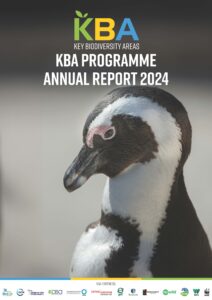The Annual Report of the Key Biodiversity Areas (KBA) Programme has just been released, spotlighting key achievements in the ongoing effort to identify and conserve the world’s most critical biodiversity sites. The KBA Programme, led by 13 international conservation organizations—including the Amphibian Survival Alliance (ASA)—works to help countries protect these essential areas, which are home to globally significant species and ecosystems.
In 2023, the program reached new heights, with extensive biodiversity assessments carried out in highly biodiverse regions such as the Congo Basin and the Andes. These assessments, funded by the Bezos Earth Fund, resulted in the identification of 651 KBAs, which were then added to the World Database of KBAs (WDKBA). These newly identified areas will play a vital role in helping countries meet the Kunming-Montréal Global Biodiversity Framework’s ambitious goal of conserving 30% of the planet’s land and marine environments by 2030.
As part of the KBA Partnership, ASA contributed to ensuring that amphibians—one of the world’s most threatened and ecologically vital groups—remain a priority in the conservation efforts. Amphibians were a key focus in countries like the Democratic Republic of Congo and Colombia, where new KBA sites are now providing a blueprint for their protection. This is crucial, as amphibians are often indicators of ecosystem health and are highly vulnerable to environmental changes such as habitat loss and climate change.
 Key Takeaways from the 2024 Annual Report:
Key Takeaways from the 2024 Annual Report:
- Over 600 taxonomic experts collaborated to reassess nearly 6,000 species across the Congo Basin, Andes, and other biodiversity hotspots, identifying new KBAs that are vital to both species conservation and ecosystem stability. The inclusion of these sites in the WDKBA ensures that governments and conservation bodies can better prioritize their efforts
- The report highlights the increasing role of the private sector in biodiversity conservation. The Integrated Biodiversity Assessment Tool (IBAT) saw significant growth in use, as more businesses began incorporating KBA data into their operational strategies to reduce their environmental impact. This shift reflects growing recognition of the value of biodiversity in sustainable development.
- Amphibians are among the many species benefiting from the newly identified KBAs. In regions like the Amazon and Andes, these areas will be critical to the survival of amphibian species that are under threat from deforestation, climate change, and disease. By prioritizing these species, the KBA Programme is helping to protect not only amphibians but the broader ecosystems they support.
- By the end of 2023, 27 countries had established National Coordination Groups (NCGs) to oversee the monitoring, reassessment, and conservation of KBAs. These groups are vital for fostering collaboration between governments, local communities, conservation organizations, and other stakeholders, ensuring that biodiversity conservation remains a priority in national development plans.
- The World Database of KBAs has been continually improved, with new features such as the integration of spatial data and enhanced functionality for the assessment and proposal of new sites. This makes it easier for conservationists and governments to use KBA data effectively in planning and decision-making.
This year’s report highlights the KBA Programme’s continued leadership in global biodiversity conservation and its growing impact on both policy and practice. As we move forward, the KBA Programme will remain central to guiding conservation actions that are critical for reversing biodiversity loss and protecting the most vulnerable species and ecosystems.
ASA is proud to be part of this global effort, particularly in ensuring that amphibians, often overlooked in conservation planning, are given the attention they deserve. The 2023 achievements mark significant progress, and we look forward to continuing our work alongside our partners in protecting these invaluable biodiversity hotspots.
You can download the report HERE.
